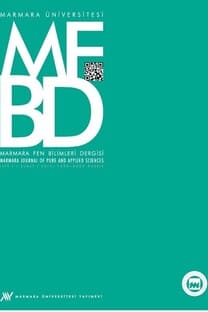Dalga Boyu Bölmeli Çoğullama Kullanan Optik Hatlarda Fiber Bragg Izgaraların Performansa Etkisinin İncelenmesi
Dalga boyu bölmeli Çoğullama (WDM) sistemi, kanal kapasitesini artırarak yüksek hızlı veri iletimi sağlayabilen bir fiber optik teknolojidir. Bu teknoloji ile, tek bir kablo üzerinden farklı dalga boylarında birden fazla kanal üzerinden veri iletimi sağlanabilir. Bu çalışmada, dalga boyu bölmeli çoğullama tekniği ve optik ağların sundukları üstünlükler birleştiğinde haberleşme sisteminde oluşacak veri kalitesi artışı ve veri kayıplarının önüne geçmek için Fiber Bragg Izgaraların (FBG) kullanımının performans artırmadaki etkisi incelenmiştir. Çalışmalar Optisystem programının 15 sürümü kullanılarak gerçekleştirilmiştir. Simüle edilen sistemlerde, hat uzunluğu 10,100 ve 200 km şeklinde seçilmiş ve veri hızı olarak ise 10,40 ve 80 Gbps değerleri kullanılmıştır. FBG uzunluk referans aralığı 2 mm ila 8 mm alınmıştır. Ölçüm sonuçlarına göre, FBG kullanılması, kullanılmamasına kıyasla Bit Hata Oranı (BER) değerini yaklaşık %50 oranında azaltıp, Q-faktörü değerini yaklaşık %6 oranında arttırarak hat kalitesine olumlu yönde etki ettiği görülmüştür. Hat kalitesindeki değişimler göz diyagramları ile birlikte görsel olarak paylaşılmıştır.
Analyzing of the Effect of Fiber Bragg Gratings on Optical Lines Using Wavelength Division Multiplexing
The Wavelength Division Multiplexing (WDM) system is a fiber optic technology that can provide high-speed data transmission by increasing channel capacity. With this technology, data can be transmitted over a single cable over multiple channels in different wave lengths. In WDM, the information carrying capacity can be further increased by increasing the data rates per channel or the number of multiplexed channels. This is accomplished by decreasing the channel spacing to 0.2 nm and increasing the number of channels, and is described by the term dense wavelength division multiplexing (DWDM).FBG is obtained by periodically changing the refractive index in a small region of the optical fiber.The basic principle of the sensors based on FBG is to determine the variation of the reflected Bragg wavelength shift due to temperature or stress. In this study, we analyzed the effect of using Fiber Bragg Grating (FBG) gratings to improve the data quality and the loss of data in the communication system when the wavelength division multiplexing technique and the advantages of the optical networks combine. Studies were conducted using version 15 of the Optisystem program. In the simulated systems, the line lengths are taken as 10,100 and 200 km and the data rates are 10,40 and 80 Gbps. The FBG length reference range is 2 mm to 8 mm. According to the measurement results, the use of FBG decreased the Bit Error Rate (BER) value by about 50% and increased the Q-factor value by about 6% compared to the non-using FBG. Changes in line quality are visually shared with eye diagrams. The contribution of the FBG sensor to fiber technology has been investigated in different ways. With these investigations, it is seen that it is possible to increase the quality of data transfer rate by using FBG sensor. WDM and FBG technologies are highly open technologies to further increase data transmission speed. In today’s technology, development studies are carried out to increase the data transmission rate to a higher level. Thanks to these studies, the need for increased data traffic will be reached.
___
- Singh, S., Gupta, N., Shukla, R. P., Sharma, A., & Singh, D. U. (2012). Simulation of full duplex data transmission in ROF system using Optisystem. International Journal Of Electronics And Computer Science Engineering (IJECSE, ISSN: 2277-1956), 1(03), 916-924.
- Akyıldız, E. (2013). WDM’in temelleri ve dispersiyon analizi. Msc. Thesis, Süleyman Demirel University, Isparta, Turkey.
- Panda, T., Mishra, R. K., Shikarwar, S., & Ray, P., (2017). Performance Analysis and Comparison of Dispersion Compensation using FBG and DCF in DWDM System. International Journal for Research in Applied Science & Engineering Technology, IJRASET, Volume5, Issue 12. ISSN:2321-9653.
- DeCusatis, C., & DeCusatis, C. J. S. (2010). Fiber optic essentials. Elsevier.
- Alcatel-lucent WDM Technology (2011) issue 1.
- Jasim, H. (2005). Optical communication system based on wavelength division multiplexing technique. PhD.Thesis, University of Baghdad.
- Coskun S., (2009). Sıcaklık ve EKG Takibi için Fiber Optik Izgara Sensör Ağı Tasarımı. MSc. Thesis, Ege University, Izmir, Turkey.
- Dziuda, L., Fusiek, G., Niewczas, P., Burt, G. M., & McDonald, J. R. (2007). Laboratory evaluation of the hybrid fiber-optic current sensor. Sensors and Actuators A: Physical, 136(1), 184-190.
- Olowo, O. O., & Abdulkareem, A. (2017). Modelling and Analysis of Powerline Temperature Surveillance with Optisystem Simulation. The International Journal of Engineering and Science, JIES, 6(8).
- Das, S., & Zahir, E. (2014). Performance enhancement of radio over multimode fiber system using fiber Bragg grating for micro and pico cell applications. International Journal of Scientific & Engineering Research, 5(7), 718-722.
- Devra, S., & Singh, K. (2016). Performance Evaluation of DCF and FBG in a WDM System with Eigth Channels in Term of Quality Factor, International Journal of Engineering Sciences & Research Technology, IJESRT, 5, ISSN: 2277- 9655
- Dallaali, M. A., & Premaratne, M. (2007). Power and dispersion constrained optimization of optical links with unequally-spaced repeater modules. Optical Fiber Technology, 13(4), 309-317.
- Hu, B. N., Jing, W., Wei, W., & Zhao, R. M. (2010, July). Analysis on Dispersion Compensation with DCF based on Optisystem. In Industrial and Information Systems (IIS), 2010 2nd International Conference on (Vol. 2, pp. 40-43). IEEE.
- Zou, X. Y., Hayee, M. I., Hwang, S. M., & Willner, A. E. (1996). Limitations in 10 Gb/s WDM optical-fiber transmission when using a variety of fiber types to manage dispersion and nonlinearities. Journal of lightwave technology, 14(6), 1144-1152.
- ISSN: 2146-5150
- Yayın Aralığı: Yılda 4 Sayı
- Başlangıç: 2011
- Yayıncı: Marmara Üniversitesi Fen Bilimleri Enstitüsü
Sayıdaki Diğer Makaleler
Süleyman ALTINKAYNAK, VEYSEL GÖKHAN BÖCEKÇİ
OYA AYDIN URUCU, Ece Kök YETİMOĞLU, Deniz DEVECİOĞLU
İki-Boyutlu Tek-tabaka Karbon Nitrürlerin Fononik Kararlılık Analizi
Beta Kesirli Türevli Kesirli Mertebeden Sınır Değer Problemlerinin Yaklaşık Çözümleri
TNOA taşıyıcısı ile MDLM Sisteminden Cd+2 iyonlarının ekstraksiyonu
Ramazan DONAT, Melike İlknur EYİCE
ABDULKADİR ATALAN, CEM ÇAĞRI DÖNMEZ, Yasemin AYAZ ATALAN
Ağır İş Dizel Motoru Silindiri İçerisindeki Soğuk Hava Akışının Sayısal İncelenmesi
